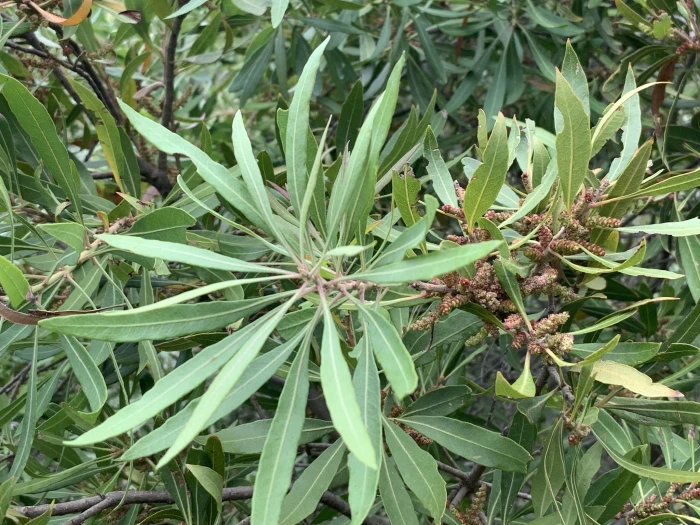Lance-Leaved Waxberry
(Morella serrata)
Lance-Leaved Waxberry (Morella serrata)
/
/

Dave Richardson
CC BY 4.0
Image By:
Dave Richardson
Recorded By:
Copyright:
CC BY 4.0
Copyright Notice:
Photo by: Dave Richardson | License Type: CC BY 4.0 | License URL: http://creativecommons.org/licenses/by/4.0/ | Rights Holder: Dave Richardson | Publisher: iNaturalist | Date Created: 2024-03-07T14:39:36Z |

















Estimated Native Range
Climate Requirements for Whitney, Nevada
| This Plant | Your Site | Plant Suitability for Your Location | ||
|---|---|---|---|---|
| • Precipitation | 10" - 114" | 4" | Your precipitation may be insufficient for this plant. Irrigate N" / year. | Irrigate N" / year |
| • High Temp. | 66°F - 98°F | 106°F | Your summers may be too hot for this plant. | Too hot |
| • Low Temp. | 26°F - 62°F | 36°F | Your winter temperatures are normal for this plant | Excellent |
This plant should grow well at your location with about N inches per year (Y minutes per month) of irrigation.
Summary
Morella serrata, commonly known as Lance-Leaved Waxberry, Mountain Waxberry, or Toothed Myrtle, is a shrub native to the fynbos and forest margins of Southern Africa. It exhibits a moderate growth rate and typically reaches a height of 5-15 feet (1.5-4.6 meters) with a similar spread of 4-8 feet (1.2-2.4 meters). The plant has a dense, rounded form with glossy, lance-shaped leaves that have finely serrated margins. Its flowers are small, yellow to greenish, and not particularly showy, blooming in the summer. The plant is also known for its waxy, blue-gray berries that attract birds and other wildlife.
Lance-Leaved Waxberry is valued for its evergreen foliage and its adaptability to a range of garden settings, including coastal areas due to its tolerance to wind and salt spray. It is often used for hedges, screens, or as a specimen plant in residential gardens. This shrub thrives in full sun to part shade and prefers well-drained soils, including clay, loam, or sandy types. It has medium water requirements and can tolerate periods of drought once established. While generally pest and disease-free, it can occasionally suffer from root rot if overwatered or planted in poorly drained soils.CC BY-SA 4.0
Lance-Leaved Waxberry is valued for its evergreen foliage and its adaptability to a range of garden settings, including coastal areas due to its tolerance to wind and salt spray. It is often used for hedges, screens, or as a specimen plant in residential gardens. This shrub thrives in full sun to part shade and prefers well-drained soils, including clay, loam, or sandy types. It has medium water requirements and can tolerate periods of drought once established. While generally pest and disease-free, it can occasionally suffer from root rot if overwatered or planted in poorly drained soils.CC BY-SA 4.0
Plant Description
- Plant Type: Shrubs
- Height: 5-15 feet
- Width: 4-8 feet
- Growth Rate: Moderate
- Flower Color: Green, Yellow
- Flowering Season: Summer
- Leaf Retention: Evergreen
Growth Requirements
- Sun: Full Sun, Part Shade
- Water: Medium
- Drainage: Fast, Medium
Common Uses
Bee Garden, Bird Garden, Low Maintenance, Potted Plant
Natural Habitat
Native to the fynbos and forest margins of South Africa
Other Names
Common Names: Mountain Waxberry , Toothed Myrtle
Scientific Names: Morella serrata , Fagus aspleniifolia , Myrica aethiopica , Myrica banksiifolia , Myrica banksiifolia , Myrica bojeriana , Myrica capensis , Myrica conifera , Myrica conifera , Myrica mossiae
GBIF Accepted Name: Morella serrata